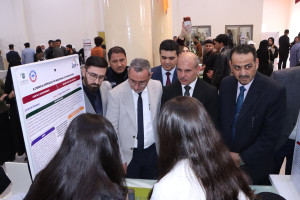
The College of Education for Pure Sciences at the University of Basra discussed a master’s thesis on the molecular diagnosis of vancomycin resistance genes for some types of pathogenic bacteria in Basra Governorate.
The letter presented by the researcher (Mohamed Abdel Bari Thamer) included
The current study aims to study the resistance of some bacterial species that are resistant to the antibiotic vancomycin. Where 121 urine and excretion samples were collected from males and females of different ages (5-65) years, and grown on a medium of Chocolate Agar for the purpose of isolating pathogenic bacteria. Then, it was grown on Nutrient Agar by Streak Plate Method and incubated at 37° C for 24 hours in order to obtain pure colonies. These bacteria were diagnosed using phenotypic methods and biochemical tests, and their diagnosis was confirmed by molecular methods through the diagnostic gene 16SrRNA, and the presence of the vancomycin resistance genes, namely Vancomycin A, Vancomycin B (VanA and VanB). On Mueller-Hinton agar medium, 40 (33.3%) resistant strains appeared, of which 13 were male samples with a percentage of (32.5%), while the number of female samples was 27 with a percentage (67.5%) and the rest were sensitive to this antigen. Four types of bacteria are resistant to vancomycin: 24 strains (60%) of Pseudomonas aeruginosa, 11 strains (27.5%) of Proteus mirabilis, 4 strains (10%) of Staphylococcus aureus, and one strain (2.5%) Actinomyces sp.. As for the presence of vancomycin resistance genes, the current study recorded the presence of 17 bacterial strains containing both VanA and VanB genes, at a rate of (42.5%), while the presence of VanA in 8 isolates with a percentage of (20%) and the VanB gene in 6 strains with a percentage of 15 (%). Also, 9 strains appeared with a percentage of (22.5%) that did not possess any of the VanA and VanB genes, although they were resistant to vancomycin, and this may be due to their possession of other resistance genes or other mechanisms of resistance to that antigen.








